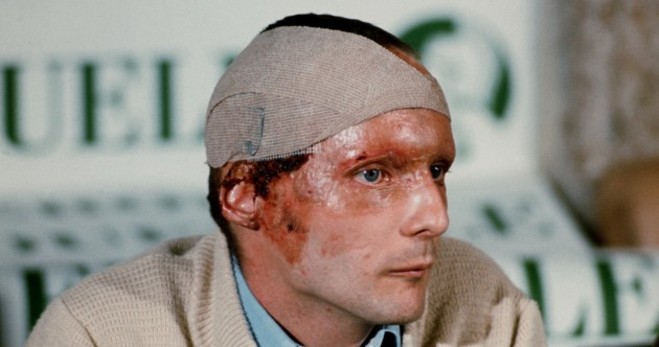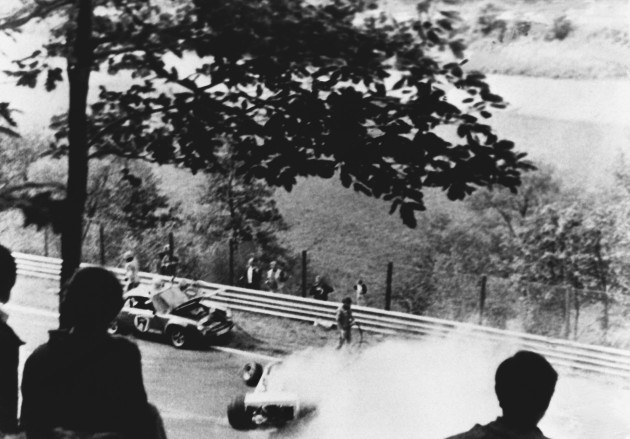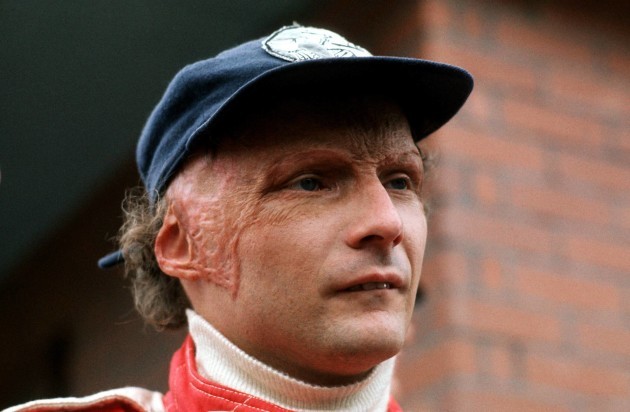“25 DRIVERS start every season in Formula One, and each year, two of us die. What kind of person does a job like this? Not normal men, for sure.”
The above words are spoken by the character of Niki Lauda, played by Daniel Brühl, in the 2013 biographical sports film ‘Rush,’ directed by Ron Howard.
The movie depicts the rivalry that existed between two of Formula One’s top competitors of the 1970s– Lauda, an Austrian driver with Ferrari and British star James Hunt of McLaren.
These opening lines set up the theme of the film nicely — it’s essentially about how much F1 stars are willing to risk and how close they come to death in order to attain greatness, or simply for the pure thrill of living in the moment, depending on your perspective.
Lauda is portrayed as the more cautious and pragmatic type, obsessed with cars and how they operate. Hunt, by contrast, is the much more fun-loving and reckless of the two, with this style on the track matched off it, given his hedonistic philosophy and penchant for excess when it comes to alcohol and women. He is the poet to Lauda’s scientist.
The movie is a relatively faithful re-telling of their story, focusing in particular on the incredible 1976 season where the pair were neck and neck in a race for the world championship.
While the film gets all the basic details correct, there are obvious limitations within the confines of a commercial two-hour movie. Lauda’s life beyond that 1976 season was similarly remarkable and for those interested in a more comprehensive portrait of the enigmatic Austrian driver, a new biography by Maurice Hamilton — a motor-sport journalist who has been covering Formula One since 1977 — does a fine job of telling his story in full.
The critically acclaimed and popular film had helped introduce Lauda to a younger generation of fans. In addition, his death last year at the age of 70, following a period of ill health, after undergoing dialysis treatment for kidney problems, served as another reminder of the Formula One icon’s remarkable life.
Noting that there had not been a book written in English on Lauda since 1987, Hamilton embarked on a biography of the racing legend, who he had had a “business-like relationship” with as a journalist.
He was not a chap you’d have a cozy chat with. He was tremendous to talk to, because everything was black and white. He would see things exactly as they are and tell you exactly as it was. He had no time for small talk, so you couldn’t exactly have a close relationship with him.”
Particularly before 1976 when a severe accident changed everything, Lauda was perceived as almost robotic. This caricature was played up to in ‘Rush,’ while his nickname — ‘the computer’ — also helped consolidate this reputation for not showing emotion. And of course, there was a degree of truth to this image — Lauda was extremely efficient at keeping calm under pressure during races. Yet Hamilton’s book paints a more complex picture, of an individual who had moments of significant vulnerability.
The path to Formula One was not easy. His grandfather was the well-known Viennese-born industrialist Hans Lauda, though his family disapproved of Lauda’s racing activities and the aspiring star cut off contact with them as a result.
A £30,000 bank loan, secured by a life insurance policy, was needed to keep his career from ending before it really began. Difficult spells at both the March and BRM teams followed in the early 1970s, and another bank loan was required.
This turbulent period, when he was heavily in debt with the opportunity of driving in Formula One seemingly having passed him by, left Lauda briefly contemplating suicide.
“He felt, in the end, his talent would out and it would allow him to earn the money to pay back the loans and so on,” Hamilton explains. “But I don’t think he realised how difficult it would be at the time.
“The only time in his life as far as we can gather that he was seriously depressed was at the end of ’72, when he realised he wasn’t allowed to drive in Formula One in ’73. And he owed all this money and he suddenly had no future. In December of that year, he momentarily thought about driving his car into the wall and just ending it all. But that was quite brief. And that was it, the lowest moment of fragility.”
Such fragility is in stark contrast with the unflappable character he was invariably perceived as. And while he maintained this stoic persona for the most part, there were often hints of a deeper vulnerability.
One of the most striking recollections in the book is from Toto Wolff, an Austrian investor and former racing driver who was friendly with Lauda.
After we [Mercedes] won the last championship in Abu Dhabi before he got ill in 2017, we were flying back and we had dinner. I looked at him and said: ‘Niki! Do you have a tear in your eye?’
“‘No!’ he said. ‘I would never have a tear in my eye.’
“Then he repeated what he had always said about having no real friends – which, of course, was absolutely not true – and talked about having no one to call if he was lying in the ditch at two o’clock in the morning. And then he looked up and said: ‘But if there is something like a half friend, you are half friend.’
“I said: ‘Niki, I cannot believe you just said that! Are you getting emotional in your old age?’ He denied it, of course. But in that moment, you could see a small but significant change in him; as if he knew something was happening.”
Hamilton continues: “He was very much the family man, very caring about other people. But being an [outwardly] unemotional man, he would never show that. You would never see that in him, as a working colleague, I just wasn’t aware of that.
“When you talk to people who knew him a long time and knew him before the accident in ’76, they say there were two Niki Laudas — the one before the accident and the one after. The one after was definitely more mellow and slightly softer certainly as far as he would be anyway, as a human being, in that his whole evaluation of life and particularly his life, was totally changed.
“He was quite clipped, very Austro-German in his approach and quite difficult to deal with. But beneath the slightly cold exterior was actually a very decent human being.”
The accident in question occurred in August 1976 at the German Grand Prix in Nürburgring. A number of high-profile tragedies meant driver safety was already a much-debated topic in the world of Formula One during that era.
Having joined Ferrari in 1974, Lauda quickly established himself as a top driver of that era, winning his first World Championship in 1975.
Yet concerned about the German circuit’s safety arrangements, the star urged his fellow drivers to boycott the race that would end up almost costing Lauda his life.
The matter was put to a vote among the competitors, with the majority rejecting the proposal, prompting the event to go ahead as originally planned.
Subsequently, on the second lap, Lauda’s Ferrari swerved off the track. His car then collided with Brett Lunger’s Surtees-Ford and consequently burst into flames. While Lunger was not seriously injured, Lauda was trapped inside of the vehicle. Lunger, as well as Arturo Merzario, Guy Edwards, and Harald Ertl all attempted to pull the Austrian from the wreckage. While they eventually succeeded, the reigning world champion was left with severe burns and had inhaled toxic gases.
Lauda recalled in a 2015 interview BBC Radio Five Live: “There were basically two or three drivers trying to get me out of the car, but one was Arturo Merzario, who also had to stop there at the scene, because I blocked the road. And he really came into the car himself, and triggered my seatbelt loose, and then pulled me out.
It was unbelievable, how he could do that, and I met him afterwards, and I said, ‘How could you do it?’. He said, ‘Honestly, I do not know, but to open your seatbelt was so difficult, because you were pushing so hard against it, and when it was open, I got you out of the car like a feather.”
Lauda was actually conscious and able to stand in the immediate aftermath of the accident, but went into a coma thereafter.
His situation was so dire that a priest arrived on the scene to give him the last rites.
“They thought he wasn’t going to last,” Hamilton recalls. “It wasn’t so much the burns on the surface, it was the inhalation. His lungs were in a shocking state.
“But apparently, from what [the medical people] said, if it had been any other person, they would have died. But because he had this driving force that made him ask him to put the pump into his lungs to evacuate all the infection that was growing all the time, which apparently was a shockingly painful process and most people would shy away from, when it was applied, they couldn’t wait to be done with it.
“But he was asking for it to be done again, because he could feel it building up, and they’d never come across anybody like that before. If he hadn’t had that determination to go through this pain barrier, he would have died, there’s no question about it.”
Hamilton continues: “He couldn’t see anything. He couldn’t speak. But he could hear. He was using that as a means of staying alert and staying conscious, pushing himself forward. At one point, the nurse said to him: ‘Would you like the priest to come?’ He wasn’t a deeply religious, but he thought: ‘Absolutely, why not?’
“And nothing happened. He couldn’t hear anything. Then he was suddenly aware of a presence. He thought at first it was the nurse. Then he realised, it was the priest, having touched his shoulder but not having said a word. Ironically, that enraged him so much that he was even more determined than before to get out of this and survive and prove that he wasn’t dead, or about to die. So it actually worked in his favour.
“Even at the height of the accident, when he was in that area where it was a big black hole, he described it as, he just wanted to fall into it and go asleep and get rid of all the pain.
“But he didn’t feel sorry for himself at all, quite the reverse.”
Remarkably, not only did Lauda recover, he only missed two races and was competing again within 42 days of the accident. In his first event back, the Italian Grand Prix at Monza, while admitting to being terrified initially, he finished fourth to consolidate an incredible return.
Despite being friendly off the track, the intensity of his sporting rivalry with Hunt was approaching its apex. While Lauda was sidelined, Ferrari even boycotted the Austrian Grand Prix in protest at the preferential treatment that they believed the McLaren driver was receiving from the sport’s authorities.
Going into the season’s climactic event, the Japanese Grand Prix, Niki Lauda looked on course to secure a second world title as he sat three points ahead of Hunt on the leaderboard.
Yet tellingly, torrential rain prompted Lauda to withdraw from the race after just two laps, citing unsafe conditions as his reason for doing so. His retirement from proceedings enabled Hunt to secure the necessary third-place finish and pip his rival to glory. Clearly, the previous accident at Nürburgring had had a profound effect on Lauda’s thinking.
“It taught him to enjoy life more and not be so wound up about it, but also, it taught him the value of his own life and why it wasn’t worth taking totally unnecessary risks,” Hamilton says.
He decided to pull out even though the whole of Ferrari and Italy were expecting him to take the fight to James Hunt. He said it was ‘not acceptable’. So that value on his life had been put there by what he’d been through.
“Don’t forget in those days, in Formula One, drivers were being killed one a month on average. This was the profession they had chosen to go into, and they accepted the risk.
“When Lauda didn’t finish the Japanese Grand Priz, Hunt was sad really. Happy to win the championship, but sad that Lauda had to do what he did, while fully respecting it.”
Hunt would never again hit those heights. He retired in 1979, going on to work as a businessman while retaining a career in Formula One as a commentator on races. In 1993, he died suddenly in his sleep.
“When I heard he’d died aged 45 of a heart attack I wasn’t surprised, I was just sad,” Lauda reflected, adding that Hunt was one of the few people he respected and the only person he envied.
And while the British star’s career petered out after that memorable 1976 success, Lauda’s shone even brighter thereafter. He won two more world titles, in 1977 and 1984, the latter occurring after an initial retirement from the sport in 1979, to work full-time on the airline he had founded — Lauda Air.
“Both decisions, to quit and come back were typically rational at the time,” Hamilton explains. “The one to quit was after he’d won the second championship following his comeback. So he’d ticked that box. He hadn’t had a particularly good year in 78-79. And the airline business was beginning to pick up. He was a pretty restless individual, so he thought: ‘I’m going to focus all my attention on this. I’ve done all I can do in Formula One. I’m a bit bored with this. I really want to focus on the airline.’ So off he went. He never thought about Formula One again, until he happened to be at the 1981 Austrian Grand Prix.
He was asked to come along and just help on the commentary. He went along not really thinking anything and was intrigued by how much the cars had changed, how much faster they got and thought: ‘I wonder if I could travel in one of these now, I wonder if I’d be capable of doing it.’
“The airline at that point was settling down. He’d got rid of some of the commitments he had. And it was a new challenge. He did the test drive. Found out he could drive the car, that’s all he needed to know. The rest he could work on — the fitness, the sharpness, and so on.”
Lauda finally retired for good at the end of a disappointing 1985 season, but continued to work in Formula One as a commentator, where his brutally honest assessments made him a much-loved pundit.
The former driver also continued to remain influential behind the scenes, working in various management roles with Ferrari, Jaguar and Mercedes over the years. He was ultimately instrumental in persuading Lewis Hamilton to switch to the latter from McLaren in 2013 — a sign of the considerable esteem in which Lauda is held by the present generation of drivers.
Driver safety was also an area that Lauda continued to remain passionate about.
“When Ayrton Senna was killed in 1994, although Lauda wasn’t driving, he was around and encouraging the drivers to get things done and act sensibly and not overreact. He was pushing behind the scenes. And they would be talking to him, because of course, they knew what he’d been through.”
A life in Formula One had rendered Lauda accustomed to tragedy, yet the accident that had the most profound effect on the Austrian occurred away from the sport.
On 26 May 1991, a Lauda Air Flight 004 scheduled to fly between Bangkok, Thailand, and Vienna, Austria crashed, resulting in the death of all 213 passengers and 10 crew members onboard.
Lauda was personally involved in the subsequent investigation and described the aftermath as the worst period of his life.
“That was a classic example of his humanity,” says Hamilton. “He was driven totally by finding an answer [as to how the crash occurred] for the relatives of the people that had died.
“Obviously, he wanted to know from his own point of view what happened to the aircraft. He knew the whole crew, so he wanted to get to the bottom of it.
One thing I did gather from the aviation people was in the aftermath, there was never any bad publicity about Lauda Air. Nobody was able to cast any blame, because he was so open. He told all the relatives: ‘You can call me anytime.’ He was taking in the region of 40-50 calls a day from relatives saying: ‘Do you know anymore, do you know why?’
“So that again shows that he wasn’t going to hide away. [The manufacturer] Boeing were blaming him and he wasn’t going to have that.
“He said: “If I am proved to be at fault, I will stop the airline tomorrow, because that’s not acceptable.’”
After a protracted investigation, Boeing admitted culpability. Lauda would later tell The Observer: “This was the first time in eight months that it had been made clear that the manufacturer [Boeing] was at fault and not the operator of the aeroplane.”
Lauda lived long enough to see his life immortalised onscreen, and despite initial scepticism, was quite satisfied with the filmmakers’ efforts once the finished product was unveiled.
“My thinking in the beginning had been too hard,” he said. “The film is 80% right when showing what happened that year. There’s a little bit of Hollywood in there, which is logical. But I have to say, especially seeing the acceptance of the people watching it, I really like it.”
Hamilton adds: “It had been an interesting experience for him, because believe it or not, he’d never actually sat down and thought about the season as a whole, because when you do it, you’re doing it and then you move on. It made him stop and reflect on it. I think his one regret was that James wasn’t there to watch it with him.”
There is a sense that Lauda has been somewhat underappreciated in terms of the scope of his achievements in Formula One. Yet in recent years, there has been a gradual reconsideration of his legacy, with ‘Rush’ starting a renewal of interest in the star that Hamilton aims to continue with this book.
“When people talk about the greatest driver, his name doesn’t get mentioned, because they’re talking about Ayrton Senna, Juan Manuel Fangio, Michael Schumacher, Lewis Hamilton now and other names like that.
The thing about Lauda is, he wasn’t spectacular. When he was in the car, he’d go by and you wouldn’t look twice. Then you’d look at the lap times and think: ‘My goodness, where did that come from?’
“He was just unobtrusive. He’d come through and win by stealth almost. He didn’t create the excitement that a Senna or a Hamilton created.
“But to go through what he went through and to make the comeback, not only after the accident, but also in ’82, and after he won a championship, is actually an incredible achievement. I hope the book will bring that point out, because I think people are now beginning to realise that he is worthy of being remembered as one of the all-time greats.”
‘Niki Lauda’ by Maurice Hamilton is published by Simon & Schuster. More info here.






